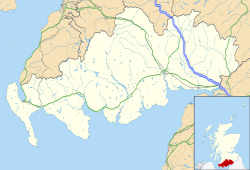| Drumtroddan standing stones | |
|---|---|
 The site in 2005 before the second stone fell. | |
| Coordinates | 54°46′01″N4°32′38″W / 54.766910°N 4.5437526°W |
| Designated | 31 December 1921 |
| Reference no. | SM90102 |
The Drumtroddan standing stones (grid reference NX 36449 44300 ) are a small Neolithic or Bronze Age stone alignment in the parish of Mochrum, Wigtownshire, Dumfries and Galloway. [1] The monument comprises three stones, only one of which is now standing, aligned northeast-southwest. [2] [3] The two end stones are 3m in length; the middle stone is roughly 2.7m long. [3] The stones were likely set up in the 3rd or 2nd millennium BCE but sites of this type are difficult to date. [2] Short stone row alignments are considered to be relatively late constructions; however, the height of the stones in this monument may indicate that it dates from an earlier period. [2]
The original purpose of the monument is unclear. It has been suggested that it may have been used in observations of the sun or moon. [2] Monuments of this type are found in concentrations in south-west Ireland, south-west Scotland, and the western seaboards of Scotland. [2] The standing stones are part of larger landscape of prehistoric sites which includes the nearby Drumtroddan cup and ring marked rocks and the Big Balcraig cup and ring marked rocks. [2]
Drumtroddan is a Gaelic name meaning 'ridge of the quarrel' from Gaelic druim 'ridge' and trodan 'quarrel, contention'. [4] [5]
